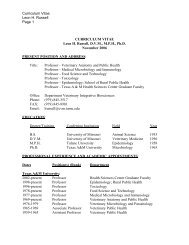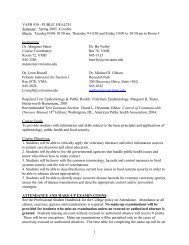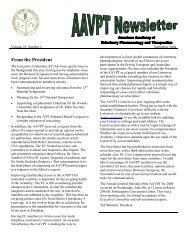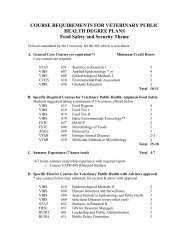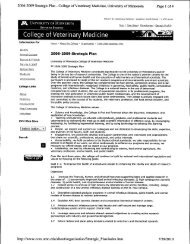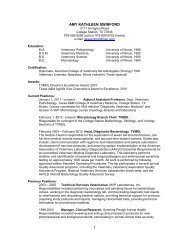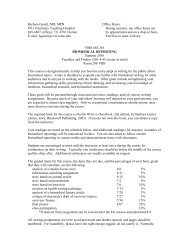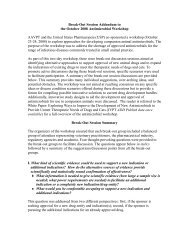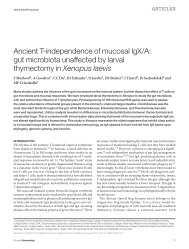Disaster - College of Veterinary Medicine - Texas A&M University
Disaster - College of Veterinary Medicine - Texas A&M University
Disaster - College of Veterinary Medicine - Texas A&M University
Create successful ePaper yourself
Turn your PDF publications into a flip-book with our unique Google optimized e-Paper software.
the toxic dose <strong>of</strong> a nanoparticle means that different metrics, for<br />
example, nanoparticle number and nanoparticle mass, are used<br />
for nanoparticle toxicity. This “dosimetric conundrum,” as Sayes<br />
refers to it, makes it difficult to compare the results <strong>of</strong> nanotoxicity<br />
studies.<br />
In a recent study, Sayes and her coauthors suggested that<br />
because there are few analytical methods currently available to<br />
measure nanoparticle mass, nanoparticle number per unit volume<br />
be used as a metric for expressing nanoparticle toxicity.<br />
Another challenge in conducting nanotoxicology studies is<br />
the lack <strong>of</strong> correlation between the results <strong>of</strong> in vitro and in<br />
vivo studies. This means that in vitro assays need to be further<br />
standardized and validated before they can be used to effectively<br />
screen nanomaterials for toxicity.<br />
Developing such in vitro assays would require careful characterization<br />
<strong>of</strong> the properties <strong>of</strong> the nanoparticles being evaluated<br />
as these properties, for example, catalytic activity or high adsorption<br />
capacity, might interfere with the results <strong>of</strong> the assay.<br />
“A detailed and comprehensive physicochemical characterization<br />
<strong>of</strong> the test material being studied...is a critical factor<br />
TThe cause <strong>of</strong> proventricular dilatation disease (PDD), a fatal<br />
neurological disorder that affects mainly captive parrots, is avian<br />
bornavirus (ABV). A group led by researchers at the Schubot<br />
Exotic Bird Health Center <strong>of</strong> the <strong>Texas</strong> A&M <strong>University</strong> <strong>College</strong><br />
<strong>of</strong> <strong>Veterinary</strong> <strong>Medicine</strong> & Biomedical Sciences confirmed this<br />
revelation in a recent study.<br />
The study, published in the March 2010 issue <strong>of</strong> the journal<br />
Emerging Infectious Diseases, is based on the fulfillment <strong>of</strong> Koch’s<br />
postulates for ABV. The postulates are a set <strong>of</strong> criteria that must<br />
be met to prove that a particular pathogenic agent causes a<br />
disease.<br />
First identified in 2008 in birds affected with PDD, ABV has<br />
been suggested as the possible cause <strong>of</strong> this disease. However,<br />
thus far, conclusive evidence demonstrating the virus actually<br />
causes PDD has not been presented.<br />
Establishing such a causal relationship between ABV and PDD,<br />
the researchers explain in the study, would require satisfying<br />
Koch’s postulates, that is, “isolation <strong>of</strong> the agent [in this case,<br />
ABV] from infected birds; its propagation in culture; and, after<br />
reintroduction <strong>of</strong> the isolate into a susceptible host, manifestation<br />
<strong>of</strong> the disease.”<br />
The researchers have demonstrated precisely these steps.<br />
The group isolated ABV from the brain tissues <strong>of</strong> eight parrots<br />
with PDD. The virus was then propagated under laboratory<br />
conditions; specifically, the virus was grown in a culture <strong>of</strong> duck<br />
embryonic fibroblasts. Fibroblasts infected with the virus were<br />
then injected into two PDD-free Patagonian conures. One Patagonian<br />
conure was injected with fibroblasts that did not contain<br />
the virus.<br />
The two Patagonian conures infected with ABV developed<br />
clinical signs <strong>of</strong> PDD. Further, brain tissues from these birds<br />
tested positive for ABV. The conure that was not infected with<br />
the virus did not develop PDD.<br />
“It’s the final act in proving that the virus actually causes<br />
PDD,” said Dr. Ian Tizard, director <strong>of</strong> the Schubot Center and<br />
head <strong>of</strong> the research group, commenting on the successful experimental<br />
reproduction <strong>of</strong> the disease in healthy birds.<br />
The study, funded by <strong>Texas</strong> A&M <strong>University</strong>’s Richard M.<br />
Schubot Endowment, represents a major step forward in understanding<br />
PDD, a disease that has befuddled scientists for more<br />
than 30 years.<br />
for correlating the nanoparticle surface characteristics with<br />
any measured biological/toxicological responses as well as [for<br />
providing] an adequate reference point for comparing toxicity<br />
results with the hazard-based findings <strong>of</strong> other investigators,”<br />
Sayes explained in a paper she recently coauthored, stressing the<br />
importance <strong>of</strong> determining nanoparticle properties.<br />
Other projects and future directions<br />
In addition to studies on nanoparticle toxicity and characterization,<br />
Sayes is investigating the use <strong>of</strong> nanoparticles in drug<br />
delivery and diagnostics.<br />
For example, a recent grant to the lab awarded from the <strong>Texas</strong><br />
AgriLife Research Vector-Borne Disease division will be directed<br />
toward using nanoparticles to prevent the toxic effects <strong>of</strong> pyrethroid<br />
pesticides after accidental exposure.<br />
In another study, in collaboration with the university’s Department<br />
<strong>of</strong> Biomedical Engineering, Sayes is investigating how<br />
quantum dots, nanocrystal semiconductors with fluorescent<br />
properties, can be used as biosensors to monitor changes in<br />
blood chemistry.<br />
Researchers confirm cause <strong>of</strong> proventricular dilatation disease<br />
Members <strong>of</strong> the Schubot research team are (from left) Dr. Patricia<br />
Gray, Dr. Itamar Villanueva, and Dr. Paulette Suchodolski, and a slide<br />
<strong>of</strong> the PDD virus.<br />
First reported in the late 1970s, PDD affects more than 50<br />
species <strong>of</strong> parrots as well as other birds. Many <strong>of</strong> these species are<br />
endangered and are raised in captivity, making PDD a serious<br />
threat to their conservation.<br />
The disease is characterized by damage to the nerve supply in<br />
the organs in the gastrointestinal tract. This affects the birds’<br />
ability to digest food, resulting in the accumulation <strong>of</strong> undigested<br />
food in the proventriculus, the first part <strong>of</strong> the stomach,<br />
which consequently dilates (hence the name <strong>of</strong> the disease).<br />
Common clinical signs include weight loss, regurgitation <strong>of</strong><br />
undigested seeds and loss <strong>of</strong> appetite. PDD can also damage<br />
nerves in the brain and spinal cord, resulting in neurological<br />
symptoms such as imbalance and lack <strong>of</strong> coordination. The disease<br />
eventually results in death.<br />
Further studies at the Schubot Center will focus on the origin,<br />
prevention and treatment <strong>of</strong> the disease.<br />
CVM Today • Summer 2010 • 15




